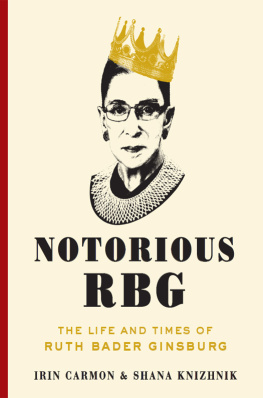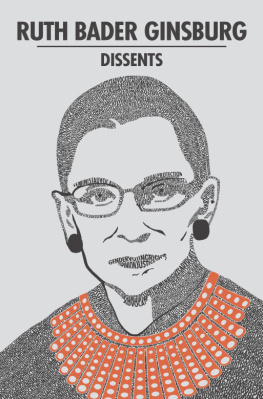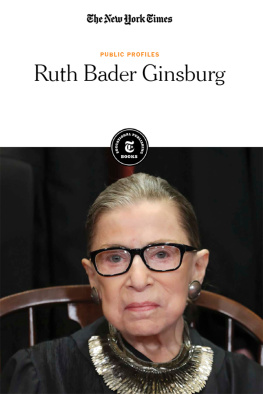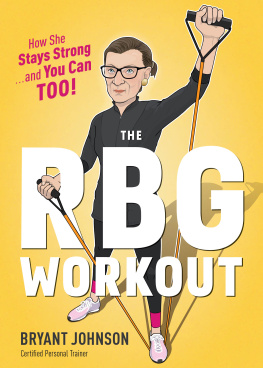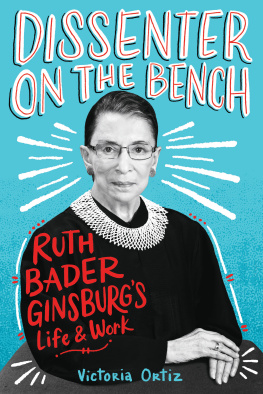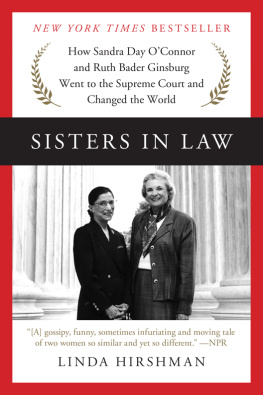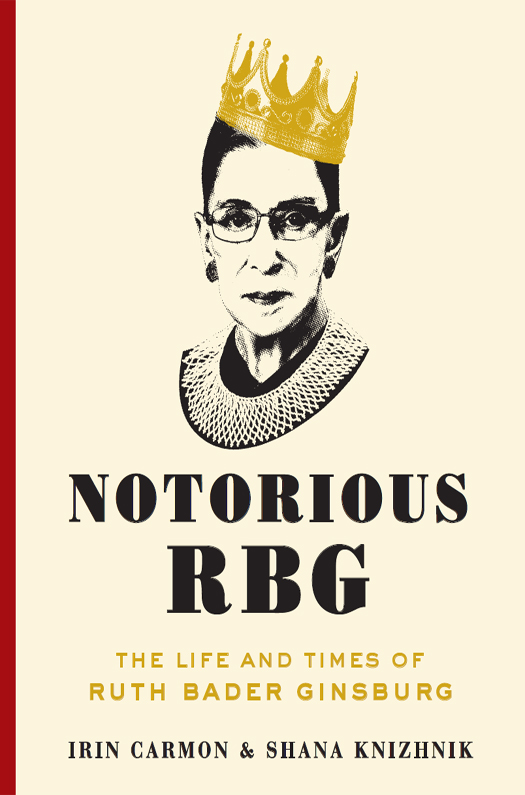
To the women on whose shoulders we stand
Contents
Guide
H I, ITS IRIN. A book is always a collaborative process, even when there is only one name on the cover. And this one has two, so I thought Id introduce the two of us and tell you how we did it. Shana, then a law student, created the Notorious R.B.G. Tumblr as a digital tribute to Supreme Court Justice Ruth Bader Ginsburg, and she sparked an international phenomenon. Im a journalist who interviewed RBG for MSNBC and will not try to wedge any more initials into this sentence. We are both #millennials who like the Internet but wanted to make something you could hold in your handsor at least keep on your device for longer than a browser tab. We both researched and reported the book; I wrote it, so if you see me, thats Irin. Shana also curated the images and fact-checked. We drew on RBGs own words, including my interview with her in February 2015, as well as our interviews with her family members, close friends, colleagues, and clerks. We also dug deep into RBGs archive at the Library of Congress. (You can skip to the end if you want to see her doodles during a conference in 1976.) We cite in the endnotes where we have gratefully relied on the reporting of others. Justice Ginsburg met with me in May 2015 to fact-check parts of the book, which involved both her patient generosity and my getting to text my boyfriend that a U.S. marshal was coming for him.
In homage to the Notorious B.I.G., the chapter titles in this book are inspired by his lyrics. We thank his estate and Sony Music for permission to use them. Artist Maria TooFly Castillo, who also runs a womens graffiti collective, beautifully rendered each chapter title. Throughout the book, youll find photographs, some previously unpublished, and the work of artists and creators moved to show their love for RBG.
If you want to understand how an underestimated woman changed the world and is still out there doing the work, we got you. If you picked up this book only to learn how to get buff like an octogenarian who can do twenty push-ups, theres a chapter for you too. We even were lucky enough to wrangle some of the most brilliant legal minds out there to help us annotate key passages from RBGs legal writing.
RBG has been extraordinary all her life, but she never wanted to be a solo performer. She is committed to bringing up other women and underrepresented people, and to working together with her colleagues even when it seems impossible. We are frankly in awe of what weve learned about her, and were pretty excited to share it with you.
I just try to do the good job that I have to the best of my ability, and I really dont think about whether Im inspirational. I just do the best I can.
RBG, 2015
T HIS IS WHAT you should look for on this 90-degree June morning: The broadcast news interns pairing running shoes with their summer business casual, hovering by the Supreme Courts public information office. Theyre waiting to clamber down the marble steps of the court to hand off the opinions to an on-air correspondent. You should count the number of boxes the court officers lay out, because each box holds one or two printed opinions. Big opinions get their own box. This contorted ritual exists because no cameras are allowed inside the court. It jealously guards its traditions and fears grandstanding.
What happens inside the hushed chamber is pure theater. Below the friezes of Moses and Hammurabi, the buzz-cut U.S. marshals scowl the visitors into silence. The justices still have ceramic spittoons at their feet. At 10 A.M. sharp, wait for the buzzer and watch everyone snap to their feet. As a marshal cries Oyez, oyez, oyez! watch Associate Justice Ruth Bader Ginsburg, known around the court as RBG, as she takes her seat at the winged mahogany bench. Look around her neck. When the jabot with scalloped glass beads glitters flat against the top of RBGs black robe, its bad news for liberals. Thats her dissent collar.
On June 25, 2013, RBGs mirrored dissent collar glinted blue and yellow in reflected light. By then, in her ninth decade of life and her twentieth year on the court, RBG looked fragile and bowed, dwarfed by the black high-backed chair. But people who had counted her out when she had cancer were wrong, both times. People who thought she couldnt go on after the death of Marty Ginsburg, her husband of fifty-six years, were wrong too. RBG still showed up to do the work of the court without missing a day. She still pulled all-nighters, leaving her clerks voice mails with instructions at two or three in the morning.
The night before had been a long one. From RBGs perch, third from the right in order of seniority, she sometimes gazed up at the marble columns and wondered to herself if she was really there or if it were all a dream. But that Tuesday morning, her eyes were on her notes. The opinion was long finished, but she had something else to say, and she wanted to get it right. She scribbled intently as Justice Samuel Alito, seated to her left, read two opinions, about land and a bitter custody case involving Indian law. Those were not the cases the cameras were waiting for. It was a two-box day. There was one more left.

Court artist sketch of Shelby County dissent from the bench, June 25, 2013 Art Lien
It was Chief Justice John Robertss turn to announce an opinion he had assigned himself. The case was Shelby County v. Holder, a challenge to the constitutionality of a major portion of the Voting Rights Act.
Roberts has an amiable Midwestern affect and a knack for simple but elegant phrases that had served him well when he was a lawyer arguing before the justices. Any racial discrimination in voting is too much, Roberts declared that morning. But our country has changed in the last fifty years.
One of the most important pieces of civil rights legislation of the twentieth century had been born of violent images: the faces of murdered civil rights activists in Philadelphia, Mississippi; Alabama state troopers shattering the skull of young John Lewis on a bridge in Selma. But for this new challenge to voting rights that came from sixty miles from Selma, Roberts had a more comforting picture to offer the country. High black voter turnout had elected Barack Obama. There were black mayors in Alabama and Mississippi. The protections Congress had reauthorized only a few years earlier were no longer justifiable. Racism was pretty much over now, and everyone could just move on.
RBG waited quietly for her turn. Announcing a majority opinion in the court chamber is custom, but reading aloud in dissent is rare. Its like pulling the fire alarm, a public shaming of the majority that you want the world to hear. Only twenty-four hours earlier, RBG had sounded the alarm by reading two dissents from the bench, one in an affirmative action case and another for two workplace discrimination cases. As she had condemned the courts disregard for the realities of the workplace, Alito, who had written the majority opinion, had rolled his eyes and shook his head. His behavior was unheard of disrespect at the court.
On the morning of the voting rights case, the woman Alito had replaced, RBGs close friend Sandra Day OConnor, sat in the section reserved for VIPs. Roberts said his piece, then added, evenly, Justice Ginsburg has filed a dissenting opinion.

